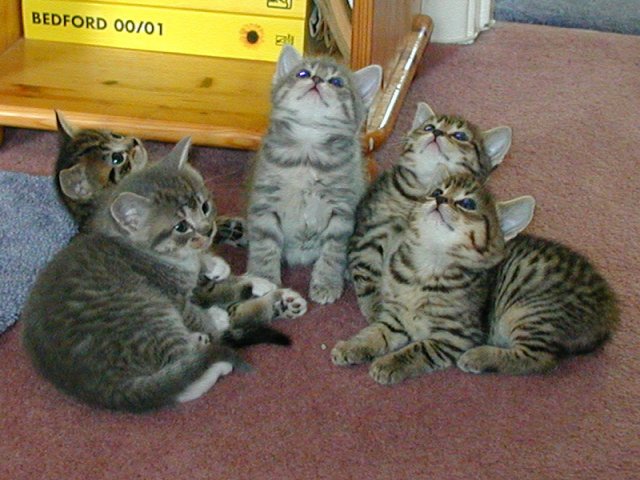
Our
Cats
Choosing a Cat/Kitten
First Intros
Handling
Litter Training
Feeding
Scratching Posts
Cat Flaps
Collars & Tags
The Problem Cat
Spaying/Neutering
Breeding
Kittening
Post-natal care
Raising Kittens
Fleas
Vaccinations
Vets Bills
British Blue Cats
Pet Insurance
Cat Pictures
Cat Humour
Links
 Kittening
Kittening
This can be quite a scary thing - not necessarily for the cat, but more for the owners! Cats are quite capable of giving birth on their own but we found that we needed to be there with our cat to help her with her birth. Obviously you should try not to interfere with nature but at the same time you should be keeping an eye on the queen to make sure that she is not in distress and an eye on the kittens to make sure that they are breathing and feeding almost immediately.
The only intervention we had was when our cat had 2 kittens in quick succession and whilst she was cleaning one, the other one was still in its membrane and was basically suffocating to death. We do not feel, that on this occasion, that our intervention was unnecessary.
Here are the stages of giving birth:
1) The queen starts to breathe heavily and rapidly and may be panting or purring but not in any obvious pain. A clear discharge can be seen. This first stage of labour can last as long as 6 hours but is usually a lot shorter. The queen may appear to be hyper-ventilating and although this looks distressing it is perfectly normal.
2) The second stage of labour begins when the queen starts "bearing down". Make a note of this time and if a kitten is not born within 30 minutes, contact your vet.
3) In an ideal birth, a kitten is born within 15-30 minutes later, enclosed in a bubble-like membrane. Most are born head first, though some may be born hind legs first.
4) As soon as a kitten is born, the queen instinctively licks it to remove the membrane surrounding it and to stimulate its breathing. The third stage of labour is marked by the expulsion of the afterbirth, which the queen usually eats. This comes from the natural instinct of the wild cat to clean the litter up as soon as possible so no predator can smell the newly born kittens.
5) Usually, the mother will instinctively bite through the umbilical cord with her teeth.
6) Allow the mother to lick the kittens straight away. She may then take a short rest before giving birth again.
7) The new-born kittens may need help in finding a teat to feed on. Make sure that the kittens are placed near to the mother's abdomen and encourage them to feed as soon as possible.
8) An average litter numbers between 2 & 6 kittens and the labour may last for several hours. You can offer the queen a little food and water during the labour though she may not be interested so do not force it on her. I would suggest leaving a bowl of water and a small dish of food next to her, however, as she will be reluctant to leave the kittens even for food or a drink.
Leave the new mum and the kittens alone so she can rest and the kittens can feed. You should try to avoid the temptation of handling the kittens as this early stage - there will be lots of opportunities in the very near future. Ensure that the new mother (particularly if this is a first litter) has food and water close by as she will be reluctant to leave the kittens.
One of our litters of kittens
